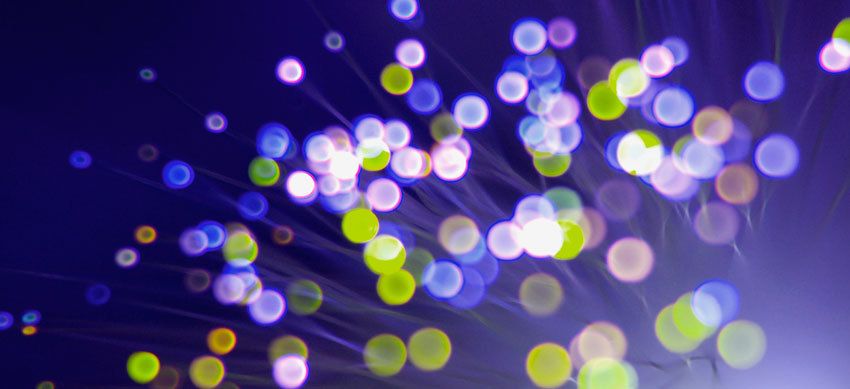PHOTONICS

The research line on Photonics at CFM deals with the study of the interaction of radiation and matter from different and complementary approaches: (i) the interaction of light with metallic and semiconductor nanostructures to confine and engineer electromagnetic fields in the nanoscale, (ii) the research on the optical properties of new materials and elements that provide improved properties in a variety of lasing effects, as well as the design of novel photonic structures that provide laser confinement for bioimaging, and (iii) the spectroscopy and photonic applications of nano-scale functional units, including different types of low-dimensional systems.
Several groups, listed below, develop research along these lines, including theoretical and experimental activity:
THE RESEARCH GROUPS
THEORY OF NANOPHOTONICS
The activity of the “Theory of Nanophotonics” group is devoted to the theoretical study of the interaction between electromagnetic radiation and nanostructured materials. The research activity of the group focuses on the theoretical study of the excitation of plasmons, quantum dots and dielectric nanostructures in the context of a variety of microscopy and spectroscopy configurations: Dark Field Microscopy (DFM), scattering-type Scanning Near-Field Optical Microscopy (s-SNOM), Electron Energy Loss Spectroscopy (EELS), Scanning Tunneling Microscopy (STM), Surface-Enhanced Raman Scattering (SERS), Surface-Enhanced Infrared Absorption (SEIRA) and Surface-Enhanced Fluorescence (SEF), among others.
In recent years, the following specific objectives have been addressed by this group: (i) understanding and characterization of the collective excitations of the electron gas, plasmons, in a variety of spectroscopy and microscopy techniques, (ii) study of metallic nanostructures as electromagnetic field enhancers and localizers, (iii) development of protocols and models to better interpret and describe the images obtained by the scattering-type near-field optical microscope, (iv) study and exploitation of the interaction of fast electrons and matter to develop new paradigms of spectroscopy in the nanoscale, (v) description of quantum effects derived from the coherent nature of the electrons that constitute a plasmonic excitation, (vi) study of the magnetic activity of dielectric nanostructures at optical frequencies, (vii) characterization of the dynamics and the coupling of emitters to be used in quantum information technology, and (viii) address non-linearities and collective effects in molecular optomechanics.
NANOMATERIALS AND SPECTROSCOPY
“Nanomaterials and Spectroscopy” group is focused on spectroscopy and photonic applications of nano-scale functional units, including semiconductor quantum dots and quantum wires, metal nanoparticles and nanoantennas and organic/inorganic nano-hybrid systems. Further research activity in the group includes the study of optical properties in semiconductor nanocrystals (quantum dots), nano-hybrid materials, heterostuctures (quantum wires), metal nanoparticles, nanoantenas and organic functional materials (J-aggregates), as well as novel experimental approaches to control, manipulate and probe with light on nanoscale.
LASER SPECTROSCOPY AND PHOTONIC MATERIALS
The “Laser Spectroscopy and Photonic Materials” group is located in the Department of Applied Physics of the School of Engineering of the University of the Basque Country (UPV/EHU) in Bilbao, and devotes most of its research efforts to the optoelectronic properties of new materials and structures for solid state lasing and photonic crystal properties. Its activity also covers the development of a complete set of high resolution techniques, the development of new low-energy phonons rare earth-doped dielectric materials for energy converters and/or solid state laser cooling applications, and the probing, characterizing, and modeling transport and/or confinement of ultrafast ultra-intense laser light in inhomogeneous (nano- micro) dielectric materials doped with optically active centers for nanosensors, displays, and bioimaging applications.
QUANTUM NANOPHOTONICS LABORATORY
The research program of the “Quantum Nanophotonics Laboratory” group aims at contributing to the development of hybrid quantum devices based on the interaction of light and matter at the nanoscale.
The Centre for Materials Physics seeks to exploit the potential and expertise of the theory groups on quantum states, and complement it with the experimental effort by this new group that can approach this topic from an applied and technological point of view.
RESEARCH FACILITIES
Optical response of metallic nanoantennas in a variety of spectroscopy and microscopy configurations.
Scanning confocal time-resolved photoluminescence setup (MicroTime200, PicoQuant) providing single molecule sensitivity and high temporal resolution. Range of application includes Fluorescence Lifetime Imaging (FLIM), Fluorescence Correlation Spectroscopy (FCS), Forster Resonance Energy Transfer (FRET), Fluorescence Lifetime Measurements, Fluorescence Anisotropy and Intensity Time Traces.
Spectroscopic equipment (Cary50, Varian) for measurement of energy transfer and conversion.
Continuous and time-resolved (with nano-pico excitation laser sources) spectroscopies with high spectral resolution in the UV-VIS-IR domains together with low temperature facilities (2K). Home made photoacoustic spectrometer.
Tunable femtosecond sources (with regenerative amplification) in the IR domain with shigh speed detectors in the picosecond domain (Streak camera). Multiphoton microscope with time-resolved spectroscopic facilities.
Crystal growth facilities by using home made Bridgman and Czochralski fournaces. Computing Facilities for Calculation of Electromagnetic Response Several computing clusters at CFM and other institutions (such as DIPC) under collaborative research. Several scientific codes for solving Maxwell equations, based on finite differences in time domain (e.g., Lumerical solutions), discrete dipole approximation (DDA), etc.
Development of own scientific software for calculation of electromagnetic response.



